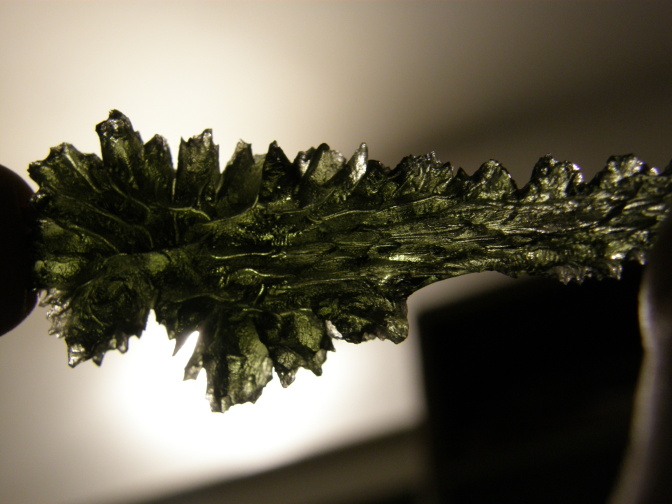
Timelines 10
Man and his Senses 10
Man and his Inventions 10
Geography 10
Fauna 10
Timelines 10
Man and his Senses 10
Man and his Inventions 10
Geography 10
Fauna 10

By the time one reads the first paragraph about moldavite, the stone has already carried a geography and a chronology in its colour , a green forest like shadow, and an origin that begins not in a mine shaft but in a meteor’s impact on earth. Moldavite is a natural glass , a tektite , formed when an asteroid struck the Earth and fused terrestrial silica into olive-green glass. The best scientific accounts place its formation in central Europe, tied to the giant impact that created the Ries crater; the glass it made was dispersed across southern Bohemia and nearby regions, and today the only known natural source of moldavite is the Czech Republic.
That origin , cosmic, sudden, and unrepeatable , is part of moldavite’s story as both material and myth. Dealers and healing-stone writers describe it as a stone of transformation, spiritual acceleration and protection, prized by collectors and meditators for its reputed ability to open the heart and third-eye chakras and to quicken inner change. As a retail copy-line and as spiritual practice, moldavite is sold both as polished cabochons and as rough pendants, its surface showing the worm-like Lechatelierite inclusions and the tiny bubbles that distinguish natural pieces from flat green glass imitations.
The stone’s hardness and glassy chemistry (essentially silica glass with variable inclusions) place it between roughly 5.5 and 7 on the Mohs scale , solid enough for jewellery but fragile enough to warn buyers: origin and certification matter.
Because the supply is geographically limited, scarcity has become a recurring theme. Many reports note rising demand and rising prices; they also warn of counterfeit pieces in circulation and advise buyers to seek laboratory certificates and reputable traders. In markets as different as the boutique websites of spiritual retailers and the websites of fine jewellers, moldavite carries two currencies: the metaphysical promise and the investment story.
Public fascination now meets celebrity curiosity. Features on “cosmic gemstones” place moldavite alongside moonstone and labradorite, noting its otherworldly origin and the interest among spiritual influencers and collectors rather than among the classic high jewellery set. These pieces, when mounted in pendants or clustered with diamonds, turn a private spiritual practice into a visible style choice. That is how a fragment of Bohemian tektite becomes, in the language of fashion and commerce, an object of desire.

Across the ocean and the arc of cultures, India is a second pillar in the contemporary gemstone story. The country’s gem and jewellery industry is vast, not merely an artisan tradition but a major industry: the sector accounted for a significant share of merchandise exports and, by recent market assessments, was valued in the tens of billions of US dollars, with strong growth expected this decade. The industry is centred in clusters , Mumbai and Surat for trade and diamond processing, Jaipur for coloured stones and artistry , and it combines centuries-old skill with modern factory systems. In short: India is where stones are cut, set, designed and, increasingly, redesigned for global markets.
This meeting of the rare Czech green gem and India’s manufacturing and market infrastructure is not merely transactional. Indian retailers and gemstone houses now include moldavite in their catalogues, offering it as a pendant for meditation or as the focal point of a custom piece. Local suppliers , from metaphysical vendors to traditional jewellers , present the stone through two perspectives of healing and adornment: advice about wearing it near the heart, suggested pairings with gold and diamond accents, and cautions about authenticity are common across product pages.These listings reveal how an imported exoticism is adapted by Indian retail practice: packaging, certification, and the sale of variant grades for different budgets.
In the past, passenger steamers and picture postcards connected Bombay and Prague; today, logistics, certification, and digital reach do the same. India’s jewellery industry has been moving beyond handcraft alone. Technology appears in design software, in the use of 3D printing for prototypes, and in e-commerce platforms that open international markets. Policies and investment have further encouraged modernisation, lab-grown diamond programmes and infrastructure such as common facility centres to train artisans. These shifts matter for stones like moldavite because modern retail , and modern buyers , demand traceability, documentation and comparison. A small green tektite that once changed hands at a country fair now arrives in a sealed parcel with a lab number and a return policy.
There is also a human connection that runs between the two geographies. Collectors who prize moldavite’s alleged “cosmic” force are the heirs to older practices in which gemstones were tokens of social standing and personal fate. Indian wedding culture and ritual adornment continue to be a major engine of demand. Meanwhile, the contemporary buyer’s appetite , shaped by younger consumers, by travel, by social media , is for pieces that can be both talisman and style statement. This is where the Czech origin story and the Indian craft economy meet: the stone supplies a narrative (born of an asteroid, rare, transformative) and India supplies the hands and the market to turn that narrative into objects people wear.
Taken together, gemstones today are multidimensional. They represent geological events and market items at the same time; they are spiritual aids and objects of investment; they are also links in a global chain that ties field and mine, cutter and designer, online catalogue and the ritual of wearing. Moldavite illustrates this: a shard of cosmic glass that, by way of sellers and certifiers and jewellers, sits on a chain at a Mumbai store or in a meditation corner in Delhi.
The past is literal , intense meteoric heat millions of years ago , while the present is cultural and commercial. .
Sources
https://tinyurl.com/y7swjem3
https://tinyurl.com/2cgjhfau
https://tinyurl.com/24yrtba5
https://tinyurl.com/23ao3wzt
https://tinyurl.com/267atncx
https://tinyurl.com/2bajjkua
https://tinyurl.com/299vd7c6
https://tinyurl.com/26xqr3st
https://tinyurl.com/2bfvhzxs